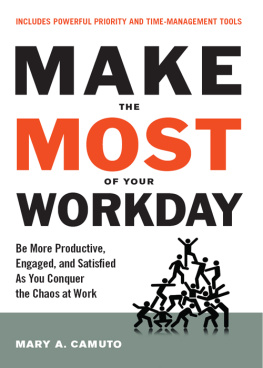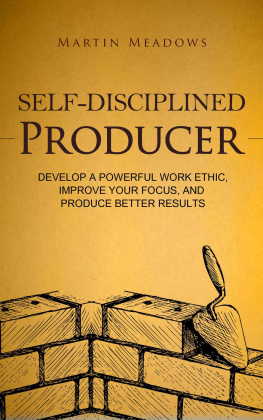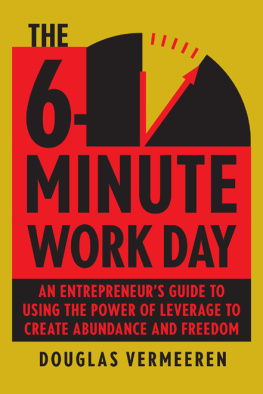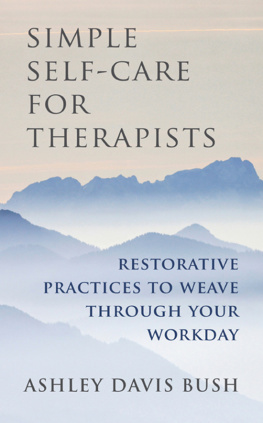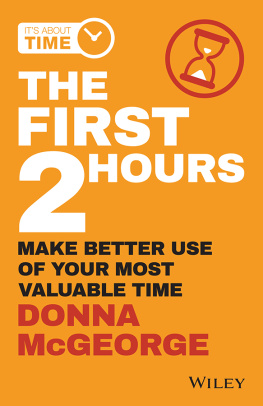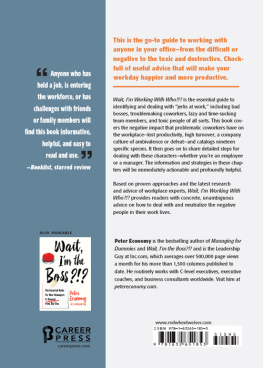
This edition first published in 2018 by Career Press,
an imprint of Red Wheel/Weiser, LLC
With offices at:
65 Parker Street, Suite 7
Newburyport, MA 01950
www.redwheelweiser.com
www.careerpress.com
Copyright 2018 by Mary Camuto
All rights reserved. No part of this publication may be
reproduced or transmitted in any form or by any means, electronic
or mechanical, including photocopying, recording, or
by any information storage and retrieval system, without permission
in writing from Red Wheel/Weiser, LLC. Reviewers
may quote brief passages.
ISBN: 978-1-63265-129-7
Library of Congress Cataloging-in-Publication Data available upon request.
Cover design by Rob Johnson/toprotype
Interior by PerfectType, Nashville, Tennessee
Typeset in Palatino LT Std and Trade Gothic LT Std
Printed in Canada
MAR
10 9 8 7 6 5 4 3 2 1
www.redwheelweiser.com/newsletter
DEDICATION
To Dad and Mom, who work so hard and with so much love for our family.
ACKNOWLEDGMENTS
I want to thank the people who have inspired and helped me to reach the finish line. First, special acknowledgment goes to my parents, brother, sisters, brothers-in-law, nieces, nephews, their spouses, and my great nephew. They each live and work with passionate interest in people, ideas, and our world, and they each create, explore, and contribute. They have cheered me on with enthusiasm and coaching throughout the good chaos of writing this book.
I am so grateful to Sharon Armstrong, an extremely generous and talented colleague; Marilyn Allen, my literary agent; and Lauren Manoy and Gina Schenck at Red Wheel, whose help was invaluable. Special thanks must go to Susan Devereaux, who brought her engagement, competence, and calm to our working relationship on this book.
Finally, thank you to Heather Purcell, Angie Arias, Frank Cole, Monsignor Sal Criscuola, and Gerald Anderson. Their positive attitudes about their work and their smiles always made my days better. Special acknowledgement and affection to Valerie Craddock, Carolyn Lomax, Laura Margiotta, and Kathy Ravenscroft with whom I have shared many great workdays and learned so much, including great dancing and singing karaoke at Foundations.
CONTENTS
INTRODUCTION
Get Your Hopes Up!
Consider that your workday has all kinds of wonderful potential:
- Income.
- Benefits.
- Achievement.
- Good relationships.
- Networking contacts.
- Fun.
- Status.
- A chance to make a difference.
- Creativity.
- Growth, learning, and development.
- A springboard to your goals and vision for your life.
M ake the Most of Your Workday is based upon the belief that each workday is precious and filled with a blank slate of opportunities regardless of your workplace, role, and types of challenges you face. My goal for you in this book is to help you find insights, strategies, and tools to move toward being more productive, engaged, and satisfied at the end of each workday. For many people, that will involve conquering some chaos that can come from many placesincluding ourselves.
Whatever your workday demands and pressures (which vary among organizations, teams, and even individuals), there are some fundamental needs that we all bring to work. These needs led to the examples, strategies, core skills, and tools that make up this book, along with experts' research from science, medicine, health, psychology, business, and education. Yet, here is the hard part and the tough news: To fully put into practice any of these ideas, you may need to change. In fact, these strategies, skills, and tools may require a real shift in your thinking and assumptions and a close look at yourself along with your coworkers and organization.
This book is a personal challenge to actively manage and make the most of workday possibilities and problems. Take some control back, if needed, and do not wait for leaders, people, or circumstances to change.
However, we have to be real and honest about this harsh workday picture: feeling what it is like to see an email inbox that is always filled with new messages on top of older, unread messages (or opened messages that you closed because you couldn't deal with them); feeling what it is like to see long lines of impatient people at Starbucks, Home Depot, Whole Foods; knowing that the queue for calls waiting for customer service is off the charts; and seeing that the clinic waiting room has long run out of chairs and several people have called in sick. Most workdays include variations of these pressures along with emotional outbursts, exhaustion, and unreasonable expectations. Each of us has a finite amount of physical, emotional, and mental energy to manage all of these things.
Besides work, we have other people in our lives and things to do, such as:
- Family needs, wants, and responsibilities.
- Celebrations.
- Health-related appointments, activities, and downtime.
- Spiritual renewal.
- Education.
- Commuting.
- Community.
- Interests and enjoyment.
Then there can be more workday surprisessome totally unpredictable and others you might have seen coming: resignations, new minefields of changes to deadlines, emergencies (real and fake), and a general sense of uneasiness. People struggle to work together when they are not at their best, don't see things the same way, and have a wide range of personality and style. Technology can seem to be managing us instead of the other way around, and the dream of work/life balance is getting tougher and tougher to make a reality. Change and complexity of these changes is increasing while resources are diminishing. There is a frantic pace in many sectors, industries, and in both for-profit and nonprofit organizations. There are many people who struggle to just survive their workday much less make the most of it.
In place of resignation as a response to all the above, I want to stir you up so that you decide to not go home disheartened every day, but to fall back, regroup, reframe, and bounce back with new strategies. The book begins with four scenarios for readers to identify with and that are intended to inspire some That's me, that's us moments.
These scenarios are fictional composites developed from real workplace experiences, diverse industries, government, for-profit and nonprofit organizations, employee engagement comments, and from challenges shared in the author's workshops and training classes. The scenarios are intended to tap into typical workday challenges and to make an immediate emotional and intellectual connection with the reader. The scenarios are not based on specific individuals.
Do you identify with any of the following challenges?
- Getting caught up in the waves of office drama.
- Watching workloads increase with headcounts disappearing.
- Feeling your interest, enthusiasm, and focus at work fade.
- Yearning for effective leadership and more time.
- Wanting to avoid working with certain people.
- Feeling at the mercy of technology and behind with weeks of unread email messages.
These scenarios will show a link from our attitudes about priorities and coworkers to our communication and time management choices with needed skills such as adaptability, focus, and proactive planning for the unexpected. The scenario characters will have Before and After profiles throughout the book so that the reader can consider how proactive strategies and tools offer the possibilities for more productive, engaged, and satisfying workdays.
Next page
